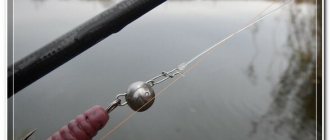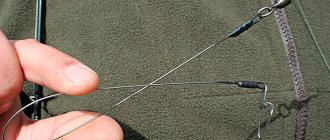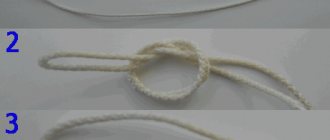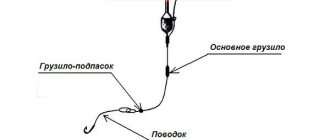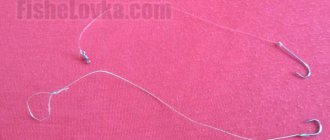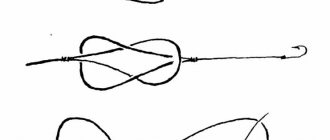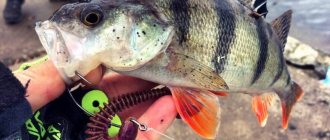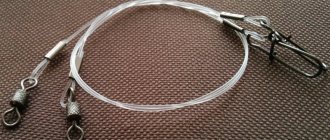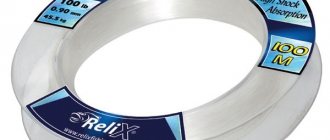This post was read by: 1,692
The leash in a spinning rod is one of those components of the tackle that simply must be present, no matter what it is - titanium, string or fluorocarbon . I think a few of my own conclusions from the practice of spinning will help some of my readers decide both on the length of the leash used and on the material from which it is made.
General requirements (classics of the genre)
A lot has been said and written about leashes in spinning rods, the topic does not subside both on the pages of the Internet, in conversations on the banks of reservoirs over a glass of tea, and in fishing stores. For some, strings are considered the optimal leashes, others, due to the trend, use a fluorocarbon leash, while others switched from strings to titanium and are overjoyed by this, and in fact it turns out that everyone is right with one constant component - The material of the leash must protect it from pike teeth, not interfere with the play of the bait and be durable against abrasion.
I once already mentioned fluorocarbon leaders from the GERMAN™ , which I have been using for the 3rd year now, and those of my friends who became acquainted with them, after some time, noted their real benefits in use, but today we will not talk about twisted fluor , but about titanium and general principles based on the length of the leash relative to the class of spinning fishing.
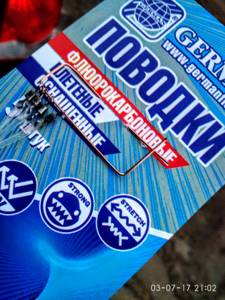
Let's look at several options using quotes from famous spinning anglers and try to analyze the leader length in one article using the example of titanium leaders from the Russian manufacturer - WIN™ company .
Let me start with my favorite class “ ULTRALIGT ” and lures of the “ Wobbler”
There are quite a few lures in ultralight less than 30 mm, and in this form, when considering this topic, I will not touch them for now (these wobblers are more suitable for the XUL class).
We will talk about wobblers from 35 mm to 70. For these baits (minnow, crank, shad, popper), the leash component is relevant for 90% of 100, and this is especially true for surface baits or baits with a large tack when twitching. So, for example, for wobblers such as crank, fat, popper, the presence of a leash does not affect their game at all. These classes of baits have a much higher degree of buoyancy than minnows, and the latter also have such a classification as “ Suspender ” where it is extremely important to take into account the weight of the leash relative to the properties of the wobbler so as not to disrupt its characteristics and play.
Let’s take a simple example, what is called “from life”. Before us are two types of leashes of different lengths and from different materials. In the first case, it is a twisted fluorocarbon leader 20 cm long, in the second - a string, or a titanium leader 7.5 cm in size (this is the minimum size in length from the manufacturer WIN™ ). We fish on a reservoir without a current, or with a very slow flow.
When using the first fluor leash, on pause and thanks to the swivel, the suspended wobbler (due to the presence of the fluorocarbon’s own degree of buoyancy) anchors (swivel) and remains above the bottom surface for as long as desired at a distance of 20 cm (leash length) and if If you reduce it (the leash) in size, the hovering (distance from the bottom) will also decrease, which can negatively affect the retrieve due to the presence of underwater vegetation.
That is, it’s trite, we will collect underwater flora in full. By the way, about the invisibility of fluorocarbon for fish - in the version of a braided leader made of this material, this factor can be questioned. The leash is woven from several (3 or 4 threads) and underwater debris in the form of microalgae is quite likely to settle between the fibers and the so-called invisibility can be easily broken.
Conclusion regarding the GERMAN fluorocarbon leash: by changing the length of the leash (shortening) we can lose the relative comfort of fishing, and a 15-20 centimeter size is quite an acceptable length when used in the ULTRALIGHT , but only in the case of leashes made of this particular material and for wobblers minnow and shad.
In this particular case, unlike the one described above, not only the weight of the leash itself is very important, but also its length. Here is a quote from Konstantin Evgenievich Kuzmin with which I completely agree:

As a first approximation, the length of the leash should be equal to the length of the wobbler itself. Well, maybe short and thick wobblers have a little more, and runny wobblers have a little less. A leash of this length gives at least a 90% guarantee against the teeth of a pike if it “swallows” it, that is, the wobbler will be completely in its mouth, and at the same time it will not overload the bait at all.
The greatest scrupulousness, as I have seen, should be shown when equipping suspender wobblers with leashes, especially small ones. Even a very small but heavy leash can upset the balance of a very capricious wobbler. To restore it, it is often sufficient to remove the winding ring, which many wobblers have on the mounting loop. Or, as an option, change the front tee to a slightly lighter one.
Konstantin Evgenievich Kuzmin
It is for this very reason that in the light and ultra-light class of spinning rods, it is worth stocking up on metal leashes of different lengths and, accordingly, different weights from 5 cm for minnows of size 35-40 to 10-12 cm for minnows of size 50-70.
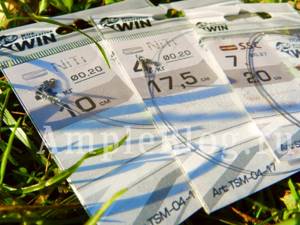
This is primarily due to the weight of the leash itself and the complete lack of its buoyancy due to the weight of the material (remember the fluorocarbon leash’s own buoyancy coefficient). That is, the shorter the length of the metal leash relative to the size of the wobbler, the better and more balanced the game, which this leash and its weight do not disturb.
As a rule, with a short leash length, the pike cannot bend it if it misses because the degree of impact resistance of a short leash is much higher than that of a longer leash. In 95% of cases, precisely in this class of fishing, pike are caught at the very edge, and fishing “in the shaft” is extremely rare. Just to maintain the overall balance of the tackle and the action of the bait, I strongly recommend leashes from 5 to 12 cm long, depending on the type of bait and its size.
We have sorted out the case with wobblers, but what will things be like in microjig? It’s not as complicated as with the wobbler theme. When fishing with a microjig, a leash is also needed and the degree of cutting of the bait by a pike increases significantly. Usually this predator waits in ambush for its prey and it is not uncommon for it to attack the bait from the side. In such cases, and with active animation + the speed of the leash, it is possible to get caught in the leash, and if there is a string, it will inevitably bend, and it will definitely not be possible to straighten it perfectly to its original state!
And here is the key point with a return to elementary physics!
Our brother fisherman, who is thoughtful in his favorite hobby, knows without a doubt that the main sensory organ of any fish is the lateral line. It is she who is responsible for the “visibility” of prey at depths where there is a lack of light, and if so, then any changes in vibrations in one direction or another can affect the bite or even the desire of the predator to attack.
For example, a pike attacked the bait from behind or across the classic line - this is undoubtedly the best option out of many possible ones.
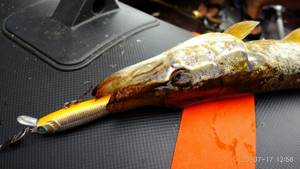
In this case, our string leash was not damaged and we can continue fishing without fear of a change in sound vibrations when the bait and leash passes through the water column (nothing changes for the fish!). But then another blow, the predator misses, hits the leash, we take out the whole, but damaged tackle and try to straighten it (the leash) in the field. We cannot do this a priori until it is perfectly even, so what will happen in the end? But in the end, even if visually the shock leader seems straight to us, it will still remain crooked and the sound vibrations will change their frequency. Whether fish will continue to be caught with this curved, stringed leader is a big question for which you can only turn to the fish, but this will undoubtedly have an impact on the overall effect of the passage of all the gear in the water column.
But what happens if instead of a string we have a titanium leash? The wear resistance of titanium material is higher than that of steel. It is more elastic and lightweight, it takes a lot of effort to bend it into an “L” shape, unlike steel, and even if this happens, at the very least it can be straightened almost to its original state simply by stretching it several times along its entire length with your fingers (under the influence of the heat of the human body, this material straightens).
The difference between a titanium leader and a string is colossal. The first is the resistance of the material to critical bending loads, the second is the specific gravity of the materials (titanium is lighter and stronger than steel), the third is that the string is several times cheaper, but if the string leader is bent, then it is better to throw it out and replace it with a new one, and the titanium leader is noticeably more expensive, but more durable.
This is what is called “Everyone chooses for himself - to pay or not to pay!”
And in conclusion, about the ideal sizes of leashes when casting with a spinning rod
The so-called commercial size of leashes produced today is 15-25 cm. According to spinning enthusiasts, it is a panacea for all ills.
Using this size in light and ultra-light spinning rods means depriving the bait of the game inherent in it, which will definitely affect bites (the exception is fluorocarbon, both twisted and single-core, from 0.45 mm and above!) - this is about the wobbler part.
Regarding jig fishing, this size (15-25 cm) is ideal due to the fact that in this particular class of spinning rod there is a significant probability of damage to the cord on shell rock and due to a single attack by a predator.
Why is it needed?
A spinning angler needs a leash in three cases:
- for protection against sharp pike teeth;
- to protect the braided cord from damage when in contact with a bottom that has abrasive properties;
- to prevent wobbler hooks from tangling with the fishing line when fishing by twitching, both during casting and during retrieving.
Today you can buy leashes made of metal (tungsten, braided steel, titanium, made from field cable strands and guitar strings), Kevlar and fluorocarbon. There are no ideal leashes: each has its own advantages and disadvantages.
Advantages and disadvantages
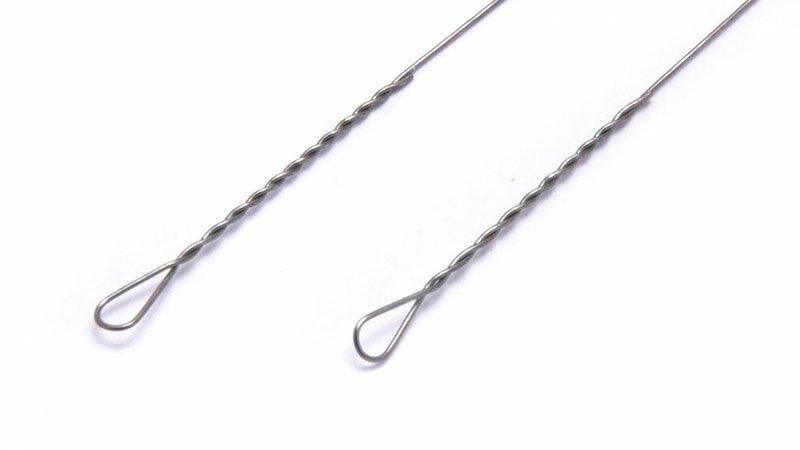
Leashes made from guitar strings have the following advantages :
- reliability in resisting pike teeth;
- rigidity and, at the same time, elasticity;
- low cost. The cost of a finished leash, even one equipped with a swivel, is lower than the notorious “green” Chinese leash, which is also less reliable and equipped with disgusting accessories;
- ease of making it yourself without the use of crimping tubes, and the cost of a homemade leash is simply ridiculous;
- the ability to quickly change baits during fishing;
- the ability to return the leash to its original shape using a lighter;
- the ability to quickly and easily add additional elements.
The disadvantages of a string leash are as follows:
- fragility. The leash loses its original shape after a bite and after contact with any obstacles on the bottom. Significant loads may cause the ear to become deformed. In this case, burrs may form that can damage the fishing line. In addition, over time, metal fatigue occurs, and the leash can break for no apparent reason;
- the possibility of rust if the leash was made of metal susceptible to corrosion. This can only happen with homemade leashes - store-bought leashes are all made of stainless steel.
Choosing the best leash for a spinning rod. Pros and cons of different types of leashes.
This is a paradox: there is a very narrow topic in spinning, on which the more you write, the more questions and doubts you have to listen to - we are talking about such a minor, in general, detail of equipment as a leash. I, it seemed to me, presented my views on what it should be in a very detailed and intelligible manner in two books, and I regularly touched on this topic in periodicals. However, as it turns out, the issue has in no way been removed from the agenda. When fishing, you often come across spinning anglers whose understanding of the optimal leash sets an example of what should never be done.
Pike was not the first fish that I caught many years ago when I began to master spinning. And not the second, and not even the tenth. From the theory I knew from books, I, of course, knew that pike teeth pose a very serious threat to the fishing line, and therefore it is necessary to put a leash, but I fished purely in Russian, i.e. according to the principle “until the thunder strikes...”.
And then one day the thunder didn’t exactly strike, but it unambiguously made itself felt. I caught an 800-gram pike with a homemade “spinner,” and while removing it from the hook, I noticed that the line immediately in front of the spinner was cut, as if it had been run through with a rasp. This means that the problem really exists, and it must be solved.
First, I found out what the retail chain was offering. In stores there were two types of leashes: half-meter long, twisted from two steel wires, with winding rings at the ends, and slightly shorter “double-knee” ones. Somehow, from the very beginning, I don’t know why, neither one nor the other inspired confidence. In addition, they were thoroughly coated with grease, which made these leashes unpleasant to the touch. And I began to look for an alternative.
At hand were 10-centimeter pieces of steel wire almost a millimeter thick. These were blanks for safety pins, I got hold of several hundred somewhere - for making the frames of rotating lures, now I decided to use them for leashes. They turned out to be short, 7-8 centimeters, but, surprisingly, over the course of several years there were only a couple of times when this length turned out to be insufficient - and the pike finally got to the fishing line with its teeth, cutting it. In later years, I note that it happened several times that the pike bit off the bait twice during a fishing trip, and the leash was longer.
Such a high efficiency of a short leash was due to the fact that at the turn of the 80s I fished mainly with hardware, and primarily with spinners. But a typical oscillating spoon is itself long, and during a characteristic bite, when a pike grabs the bait across, contact of the teeth with the fishing line is practically impossible. Only if the spinner is compact, like a “Spoon”, or the pike is large. However, I didn’t catch large pike at that time, so the question of lengthening the leash was irrelevant.
But then I began to slowly master jig fishing. And problems immediately emerged: on two fishing trips in a row there were offensive cuts. It became clear that such “chain mail” for fishing with “foam rubber” and its analogues were a bit short, it was necessary to look for an alternative again...
The further course was predictable: the leash requires wire, and the easiest way to find it is in the Cultural Goods store, in the Musical Instruments department. Half the counter there was occupied by a variety of strings - from balalaika strings to those that were used on instruments, the name of which didn’t mean much to me at the time. I found out which ones were cheaper - they turned out to be balalaika ones. The problem is mostly solved.
I made leashes 12-15 centimeters long from strings. There is only one thing that I had not decided on at that time - what kind of strings are optimal as raw materials for leashes. I used those that were currently on hand.
Certainty came after I took part in competitions on the Shatura Lakes. This was already in the late 80s. At the base, one of my roommates turned out to be the then Moscow champion in spinning, Alexander Kovalenko. From him I learned several interesting things, including about leashes. Yes - a string, yes - a guitar string, specifically - No. 2. It is convenient and reliable - both in general and for jig fishing in particular. And Kovalenko was just a representative of the jig school; he actively caught the then relatively little known foam rubber fish.
Since that time, I have made almost all of my leashes from guitar strings - “twos”. The string leash has now become so popular that, I estimate, at least half of the metal “B” guitar strings sold in Moscow are used not for their intended purpose, but by us, fishermen. I think if, for example, Paco de Lucia or Sir Paul McCartney found out about such a barbaric attitude towards the most important detail of their favorite instrument, both would shed a stingy male tear.
It turns out that I have been using leads made from strings in general for 25 years, and purposefully made from guitar “twos” for more than 15. Time is more than enough to identify all their relative pros and cons. But first, I’ll say not about guitar leads, but about some of those that were considered, or even continue to be considered, as an alternative to them. Let's start with a couple of practical examples.
1996, competitions near Saratov. The FireLine cord had just appeared. If you remember your first impression of it, then most likely it was something like this: the new cord is something armored and invulnerable. So one of our team members, Vladislav R., confident in this, decided to use the 20-gauge Fire as material for leashes.
We fished not far from each other, so I saw the key episode from beginning to end. A pike weighing about 7 kilograms landed on Vladislav’s wobbler. He fished it competently, but when it seemed that the “crocodile” was about to be in the boat, a subtle movement of his head followed - and the leash was cut in half. Vlad was so upset that he was no longer able to catch at full strength until the finish line and brought “zero”. If he had taken that pike, we would have been first, but as it is, we barely managed to grab third place.
2000, “pilot” Russian Championship near Krasnodar. The namesake of our previous hero, Vladislav N., used Kevlar leashes, which were very strongly recommended to him by an acquaintance who worked in a fishing store. After all, body armor is made from Kevlar and many other things that are heavy-duty and impenetrable.
The bite back then was so-so, and a pike with a threshnik already definitely guaranteed Vlad a place in the prize-winners. In short, you understand: Vlad had a chance to take one, and a very real one, but it all ended exactly the same as in the previous example - as soon as the pike brushed its teeth on the leash, it fell in half...
Nowadays, few people have illusions about multi-filament cords - it is well known that pike bite them with almost the same ease as monofilament fishing line. But many spinners continue to get burned on Kevlar. I would like to hope that this publication will become a deterrent warning for someone: simple Kevlar, without metal reinforcement, is in no way capable of resisting pike teeth. There is nothing paradoxical in this, because the nature of the load from a bullet hitting a bulletproof vest and from a “saw” passing along a stretched leash are very different.
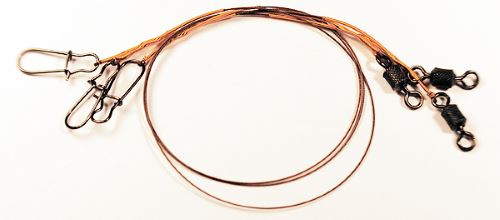
With this paragraph of this publication, I risk incurring the wrath of our fishing merchants who sell a variety of ready-made leashes and semi-finished products for them, as follows from the very name of this paragraph. Recently, there has been increasing interest in semi-finished products, which allow the fisherman to make his own leashes of the required length and breaking load. Here we are already talking about those leader materials that are really capable of resisting pike teeth. If it’s the same Kevlar, then not by itself, but already reinforced with a metal cable.
There are a lot of options for leader materials. The most popular is 7x7, i.e. 7 steel threads are collected into one flagellum, and then a leash is twisted or woven from seven of these - or its semi-finished product, usually sold in unwinding lengths of 5 m or more. There are leading materials, cheap and expensive, relatively hard and very soft, those that can be tied with the most ordinary knots, and those that require crimping tubes.
Out of curiosity, I tried, if not everything that is available in fishing stores on this topic, then a lot. And he invariably discovered certain shortcomings. Some of the leader materials were much worse at tying knots than promised. Others required extreme care in manufacturing: if you pressed it a little, squeezing the fixing tube, the leash easily breaks in this place; if you didn’t tighten it enough, it slips out. I won’t cite all the negativity about lead materials here, but no matter how much I tried to objectively compare them with a guitar string, it turned out to be a one-sided game - the string is better in all respects.
More precisely, not in all of them, but this is not directly related to spinning. It’s just that many people don’t really understand what exactly these or other leash materials were originally intended for. At least those that are as soft as possible are designed primarily for fishing with natural bait. In our interpretation, these are, to put it mildly, “semi-sporting” gear, such as girders or circles, where in the vast majority of cases the fishing scheme involves the pike swallowing the bait, and a hard leash often results in a large number of bites that are not brought to a logical conclusion. In spinning, as you know, almost always the hook follows immediately after the bite, and whether the fish feels a hard leash or not - the result in no way depends on it.
Another question that often arises is posed like this: a leash made of soft material minimally distorts the “game” of the bait, while a hard leash made of string simply cannot help but influence it, right? This is possible, but only if the guitar leash does not correspond in its parameters to the type and size of this bait. We will further dwell on this correspondence in more detail, but for now I will allow myself to limit myself to the shortest possible remark: for approximately half of the types of spinning baits (these are jigs, spinners, spinnerbaits, etc.) the formulation of the question itself is incorrect - these baits do not have a wobbling “game”, which could fundamentally be disrupted by a rigid element located in front.
For others, something similar is possible, but only if there is a large imbalance between the characteristics of the bait and the leash. At the same time, often soft leashes, which, as a rule, require some kind of adapters in the form of fasteners and swivels, have an even more noticeable effect on the “game” of the bait.
However, the first two questions (the impact on the quality of the bite and the “game”) are closer to philosophy. Much more significant for us is the third question: how strong are they guaranteed - leashes made of different materials? And this is where much of what is usually considered as an alternative to the string simply fails miserably.
But let's move on to the designated issue, starting with one type of leash that is quite popular among our spinning anglers.
I remember how at some competition back in the last century I took a prize place, for which I was given a large bag with all sorts of fishing stuff. There was an inexpensive reel, two skeins of braided fishing line, a dozen wobblers, I don’t even remember what, and plus a couple of dozen leashes, so beautiful, deep green.
The idea immediately arose to give all these green Chinese leashes to someone right away - I had been using string leashes for a long time and had no reason to complain. But banal curiosity took over: I wanted to understand what to expect from, as they called then, a “lice test,” or, if you prefer, a crash test.
The results were simply stunning! Firstly, the average load from which these solid-looking leashes became unusable turned out to be much lower than one might have expected. I don’t remember exactly, but something less than 4 kg. Secondly, the leashes were destroyed with approximately equal probability in three different places: either the loop of the leash itself broke, or the clasp unbent, or the swivel to which the fishing line was tied fell apart in two.
Another time or two the leash simply snapped in the middle. Thirdly, the spread of breaking force turned out to be very large: different leashes from the same “bunch” could last a long time even with two kilograms of load, and with more than six kilograms. Such a large dispersion in such characteristics is always bad, especially when you know about it in advance. For example, a pike sits on your “threshnik”, and now you think - what to do, either drag it confidently, not giving it a chance to get caught in the snags, or, on the contrary, let it walk, fearing that the leash was caught among the weakest? Such doubts do not lead to anything good.
Those leashes, which served as the source material for the crash test, a little later began to be collectively called “green-Chinese.” Most often they are green, although there are also, for example, black ones, and the country of origin is not in doubt. At the same time, among the “green-Chinese” leashes there are also quite reliable ones (I don’t mean individual leashes from a “bunch”, but entire batches), but, anyway, when dealing with them, we are almost always dealing with a pig in a poke. It is impossible not to notice that the trend towards a general improvement in the quality of fishing (and other) products produced in China is now becoming increasingly obvious. So in a few years the situation may change very noticeably. But we still live with current realities...
The situation with green Chinese leashes is by no means unique. A large variation in breaking force is typical for a variety of “non-guitar” leashes, and by messing with them, you doom yourself to playing the lottery: whether it breaks or not, whether it’s the leash itself or the accessories. I once tried accessories from a very expensive Japanese company. More reliable, of course, than outright consumer goods, but there were still several cases when the fasteners unfastened on their own, and the swivels broke under more than moderate loads. Therefore, I decided to give up all this, especially since guitar leads do not necessarily require any accessories.
The floater’s approach to the leash is such that this part of his tackle should be consistently less durable than everything else. You and I have a completely different situation. So let's talk about what is reliable and predictable.
So, the base material of the leashes is guitar string number two from the Ramensky plant. It allows you to achieve a guaranteed tensile strength of about 15 kg, and more often the fracture limit is even higher. This, as you understand, is quite enough for the vast majority of cases when we fish with a spinning rod.
In an ultra-light class (and sometimes light) spinning rod, you can use the number one string. There is a guaranteed load of about 7 kg - more than enough.
I would like to note that I use ramen strings as a basis. On the one hand, they are easier to find than other cheap guitar strings in the capital and surrounding areas, on the other hand, they completely suit us in terms of their physical and mechanical characteristics. In other regions, strings from other manufacturers are more often sold, and the wire used in them may not differ for the better from Ramenskoye.
Actually, at the Ramensky plant several years ago there was a period when strings were made from a material with significantly different properties. For the “two” they used wire with a diameter of not 0.4 mm, but 0.35 mm, and moreover, more brittle. For the last three years, this problem has not appeared at all.
I will also add that the strength of the leash depends not only on the wire itself, but also on the execution of the twist; later we will say a few separate words about this.
What is the optimal leash length for catching different fish?
With the strength of the guitar leash, everything is more or less clear. But with what its length should be - not very much. Here, a lot depends on the type of bait, the species and size composition of the fish we are counting on.
With “turntables” and “oscillators” the situation is relatively simple - the leash for them can be quite short, but if it turns out to be longer, this is unlikely to have a negative effect on anything. Usually, when I catch pike (or anything in a row, including pike) with a medium-sized spoon, a 10 cm long leash solves all the problems. If we catch perches with a small “spinner”, but there is a certain probability of a pike attack, then a leash length of 7-8 cm will be just right; it’s better if the leash is made of string No. 1.
The most popular length of my jig leashes is 12-17 cm, sometimes (if a large pike is caught) I increase their size to 18-20 cm. However, in jig fishing by lengthening the leash you can hardly achieve a 100% guarantee against cutting - unless by increasing it to more than half a meter . All this is due to the fact that the pike sometimes (especially when moving downstream) attacks the jig bait both in front and in anticipation at the same time - and sometimes runs its teeth onto the cord 30-40 centimeters from the bait. At least, I used to connect (precisely in anticipation of such bites on the line down the river) two of my standard leashes in series, and this did not help.
What you see in the photo with a large pike, where two leashes are connected to each other, is an example of when this is completely justified. The location of the action is the Cheboksary reservoir near Vasilsurskaya Sloboda, where “crocodiles” are quite common animals. And they grab the “foam rubber” completely unceremoniously - from the side, behind, in front, in short - at random, so it’s better to have a longer leash. In the absence of one long one, I put two short ones.
But still, in the region of “evil crocodiles” we happen to catch relatively rarely, and usually the standard 15 cm for a leash for a jig is more than enough.
With wobblers, you can, as a first approximation, follow the rule: the length of the leash should be equal to the length of the wobbler. Well, maybe for fats the leash should be 3 centimeters longer, since fats themselves are short, and pike, even relatively small ones, tend to “swallow” them.
In general, the topic of “wobbler and leash” is one of the most frequently raised. It is here that our brother is tormented by doubts. Let me note in this regard that the guitar leash weighs almost nothing, its mass is approximately equal to the mass of the winding ring, which most wobblers have on the front loop. If you are afraid that the balance will be disturbed by the leash, simply remove this ring. However, it is worth taking into account that most wobblers that pass as suspenders actually have weak positive buoyancy, and from 50 to 250 mg (this is a characteristic mass range of guitar leads - depending on their length and thickness) rather contributes to the wobbler approaching its declared type, which upsets the balance.
Length of string leader when fishing with jig
As with jigs, “planned” bites sometimes occur with wobblers, which are difficult to combat by increasing the length of the leash. This includes hitting the cord with your teeth when biting in advance, and a more “sophisticated” option, in which the pike suddenly begins to spin around its axis, winding the cord around its muzzle, and it sometimes ends up on its tooth. This happens to me once every four years - as if on a schedule - a kind of fate, it’s useless to fight. Although the pikes that leave are all large. It's a shame, though.
Finally, when I fish in purely perch ponds (i.e. where there are actually no pike), I use a micro leash - 2-2.5 cm long, which mainly acts as a fastener. However, it can also play a defensive role if suddenly a small bee that came from out of nowhere attacks the wobbler or spinner. Still, sometimes these very few centimeters matter.
Any ready-made leash sold in a fishing store costs some money. “Green-Chinese”, of course, is inexpensive, but for one made of serious leader material, plus hung with branded fittings, they often want how much a budget wobbler costs. It is not right. Guitar leads, if you make them yourself, cost mere pennies - a set of three strings, from which one and a half dozen leads come out, can be found in stores for 8-10 rubles. True, when making leashes with our own hands, we spend time and effort, which also cost something, but this is a slightly different question.
This question arises most acutely in a situation where you have to go fishing early tomorrow morning, and there are zero leashes available, so you have to quickly grab wire cutters and pliers. In this regard, the idea has long occurred to me - to put the production of guitar leads on stream. At the same Ramenskoye factory, for example. What difference does it really make to them whether they produce strings or ready-made leashes?
Someone is already producing guitar leashes in small series for sale - I saw them in a couple of Moscow stores. But, firstly, they get lost against the backdrop of counters bursting with more flashy goods, secondly, they still cost a little more than would be justified, and thirdly, they are not executed in the most ideal way.
One of the most important advantages of a guitar leash is the convenience and reliability of attaching bait to it. For those who are not in the know, let me explain: no clasps or winding rings are required here; the pre-twisted end of the leash is simply untwisted with your fingers, the bait is attached - and the twist is rolled up again. With some skill, all this is done very quickly - literally in a couple of seconds. However, there is one “but” here: the twist must be correct and familiar.
Correct means this: it is important to twist the main piece of wire and the side one symmetrically relative to each other. The most common mistake is to leave the main piece straight and just wrap the end of the wire around it. If so, then the twist strength will be lower, and the operation of replacing the bait will become less easy. The twist pitch should be medium; too steep a pitch makes it difficult to replace the bait, and twisting at a small angle is somewhat weaker in strength.
The familiarity of twisting suggests that the pitch of the turns in it is exactly what you usually deal with, and the direction (clockwise or counterclockwise) is the same. It’s just that sometimes you happen to use other people’s guitar leads - for example, when you run out of your own, you take it from a friend - and you immediately feel the difference. With your own leashes, all manipulations can be carried out even in the dark, with strangers, which are at least slightly different, there is some discomfort.
I will briefly dwell on several important questions that inevitably arise before those spinners who are just discovering guitar leashes.
If you use a braided cord, then there should be no “architectural excesses” not only at the back end of the leash, but also at the front end. The leash is attached to the bait, as you have already understood, by twisting and unwinding, and the “braid” is simply tied directly to its front end. If such a leash has a swivel, remove it and throw it away, or at least put it away.
It is absolutely unnecessary from a variety of points of view - and its anti-twisting properties are greatly exaggerated, and it can play the role of the “weak link” perfectly. Tying the cord directly to the wire leash does not in any way affect the strength of the knot; in the case of a monofilament, it is worth installing an adapter in the form of a winding ring or the same swivel, only from those in which you are confident.
Most guitar leads are made symmetrical - with the same twists in front and back. But for those leashes that are designed for jerk fishing, the front twist should be slightly different. It’s just that when fishing with poppers or minnows, the bait along with the leader periodically slips forward relative to the cord, and with the next pull the cord can get inside the twist, which, of course, is not good.
Therefore, the first couple of turns of the front twist are performed as usual, and then the tip is simply wrapped around the main wire. Such a twist turns out to be one-piece, but for the front end of the leash there is no special need for detachability.
Using the guitar leash, you can “read” some of the nuances of the bite. For example, if after contact with a predator the leash is bent at an angle (often close to straight), it means that the attack was from the side and in front of the bait. Often the result, as in photo 7, is something very similar to a spiral. This happens when we half-heartedly clamp the wire with pliers and pull it through with a sharp jerk. In this case, pike jaws acted as pliers (the pike slightly missed and hit the leash), and the jerk in the form of a hook turned out to be effective - the hook found something to grab onto.
A transparent plastic pencil case, as shown, is very convenient for storing leashes. For example, long floats are sold in such tubes. We can at least throw away the float, but the “container” will be useful to us. Is it worth shortening the pencil case to the optimal length (18~20 cm).
The leash is a consumable item. He rarely lives for more than two or three fishing trips. But sometimes among the leashes you come across “active long-livers” - in the sense, those that do not lie for several years “in a dry and dark place”, but are often used for fishing and do not want to come off. Here it is worth keeping in mind that the physical and mechanical resource of the leash is still limited.
It is more or less guaranteed to withstand about fifty twisting and untwisting operations; if more, the wire at the twisting point may simply break from a small force. The “veteran” must be sent to “retirement” on time!
What was said above about the much lesser suitability of various leader materials should not be understood in a completely radical way. Just a couple of weeks before writing these lines, I received a leader material from American Fishing Wire - unlike others, it was almost identical to our guitar string, and even turned out to be a little more powerful! Thickness - 0.45 mm, guaranteed strength - 17 kg, flexibility and elasticity - very similar, and the price is affordable, plus an anti-corrosion coating.
A guitar string, however, is also not particularly vulnerable to rust, except in brackish water - such as the Azov estuaries, where it cannot withstand more than one or two fishing trips. This is all to say that if suddenly in your city there are no “correct” strings in the department of musical instruments, sometimes you can find an alternative in a fishing store. It sounds somewhat absurd, but still.
Read other articles, reviews and testimonials:
- Spinnerbait. How to catch pike and perch with a spinnerbait
- Review of the Major Craft Basspara spinning rod. Reviews from fishermen about the Major Craft Basspara spinning rod
- Review of the Imakatsu Riprizer 60 F wobbler. Wobbler wiring
- Inexpensive light class spinning rod Favorite Laguna 662L LGA-662L with 3-12g dough for catching perch and pike
- Review of the Aiko Butch spinning rod. Reviews from fishermen about the Aiko Buch spinning rod
What kind of fish should I use it on?
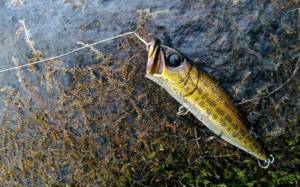
The logical answer that immediately comes to mind is pike. But even when catching a toothy predator, the unconditional use of a string leash does not always make sense. In what cases does a string leash have no competitors?
First of all, when fishing in places rich in hooks . The low cost of string leashes makes them a consumable material that you don’t mind leaving on the bottom. Naturally, this applies to jig fishing and fishing with spaced rigs, when the baits themselves are inexpensive. The rigidity of a string leash makes it unsuitable for girder fishing, when it would be more appropriate to use leashes made of elastic leash material.
Expert opinion
Knipovich Nikolai Mikhailovich
Zoologist, hydrobiologist. I am interested in fishing at a professional level.
Healthy! For fishing with girders, two-piece leashes can be made from string. The flexible joint will provide freedom of movement for the baitfish.
By definition, a string leash cannot be damaged in contact with snags, stones and shell rock, so it is used when fishing not only for pike, but also for perch and pike perch, when fishing takes place on the bottom, rich in such obstacles.
When fishing with wobblers using jerk wiring, treble hooks often get caught in the fishing line. The main objects of twitching fishing are pike and perch, and much less often pike perch. To reduce the number of overlaps, use rigid string leads.
Finally, string leashes can be used when catching small catfish, since the brush located on the jaws of these predators has the ability to grind the cord. But if an angler is aiming to catch trophy catfish, then it is better not to take risks, since guitar string No. 2 is unlikely to cope with the resistance of the river giant.
How to choose in a store
Today, ready-made string leashes can be bought in almost any fishing store. When choosing a leash, you should consider its parameters such as length and breaking load, and also pay attention to the quality of workmanship. The twist should be even, and its tip should not stick out.
Expert opinion
Knipovich Nikolai Mikhailovich
Zoologist, hydrobiologist. I am interested in fishing at a professional level.
Attention! For jig fishing, it is recommended to buy leashes with a breaking load that exceeds the values necessary for the upcoming fishing. A thick leash will deform less, and a slightly thicker leash is unlikely to scare off our freshwater predators.
If you plan to fish with wobblers using jerk wiring, then you should approach the choice of leashes more responsibly. A leash that is too heavy (due to excessive length and thickness) can turn a floating wobbler into a bait with neutral buoyancy or make a suspended wobbler a sinking wobbler. Therefore, a leash is chosen based on the principle of “do no harm.”
To catch pike, the leashes should be thicker - usually the diameter of the string is 0.32-0.33 millimeters, while perch is caught with leashes made from string No. 1, which has a diameter of approximately 0.15 millimeters.
String
The string leash has a very wide application, as it is light, cheap and reliable (photo 6). If we compare leashes made of steel string without fittings and titanium, where fittings are initially present, the first one, with equal strength, will be on average 25% lighter. The fluorocarbon leash, in turn, is heavier than the titanium one by the same 25% with the same length. However, due to the tendency of steel string to curl into a spiral when catching a fish or freeing it from a hook, I try to use the string as little as possible. For example, when catching pike with topwaters. If you still use the string as the main leader in your arsenal, I would pay attention to the fact that the string should in no case be shiny, since the pike will often attack the string, apparently trying to intercept prey from another small predator. And this leads to offensive cuts. You can make any string matte by immersing it in phosphoric acid for a couple of hours. At the same time, it will acquire anti-corrosion properties.
How to choose the length
The choice of leash length is determined by fishing conditions, namely:
- When fishing on the bottom, which has abrasive properties, you can use leashes up to half a meter long.
- When fishing with wobblers using jerk wiring:
- for perch – 5-7 centimeters;
- for catching pike with wobblers 80-100 mm long - leashes 10-15 cm long;
- for fishing with wobblers 130 mm long or more - leashes 15-20 cm long;
- For catching large pike – 20-30 cm long.
Sometimes the pike hits the bait ahead of the curve and bites the cord, cutting off the bait. Knowing the peculiarities of predator behavior in a particular body of water, you can prepare leashes of the required length in advance.
Basic fluorocarbon leader for twitching
Many fishermen use fluorocarbon fishing line as the main fishing line for twitching, which, in general, is correct. But, it seems to me, it would be a little illogical to tie an opaque leash to the end of the fluorocarbon, especially since you still have to put a swivel between the string and the fluorocarbon, since without it the string will simply cut through the fluorocarbon. As the main leash for catching pike with wobblers 130 mm long, I use homemade flur leashes with a diameter of 0.6 mm. They protect against shearing in 99% of cases, do not get caught behind the front tee, do not glare (like strings), and help guide the wobbler as deep as possible, which, as a rule, affects the size of the fish caught. The cost of the leash is low, however, it is not so easy to make.
We take a piece of fluor 25–30 cm long, melt the ends until balls form on them. Then, bending 1.5 cm and putting on the fastener, we make a bandage of 20–25 turns of braided braid with a diameter of 0.2 mm. Having tightened the bandage as tightly as possible, you need to tighten the flute itself so that the fastener does not dangle (this will limit the freedom of the leash and prevent overlaps over the tee of the wobbler). Now you should finally tighten the bandage and trim the ends. We repeat the same on the swivel side. Finally, we coat the bandage with a transparent protective varnish, or manicure varnish.
You can also use crimp tubes. Leaders made from fluorocarbon using crimp tubes are good because they have the maximum possible breaking load for a given fluorocarbon diameter. It is very beneficial to use such leashes for fishing in snags, since if for strings and cables 10 kg of breaking load is the limit, then with the help of thick flurry you can approach 20 kg.
How to make it yourself
The ease of making a string leash with your own hands is one of the advantages of this accessory.
Classic
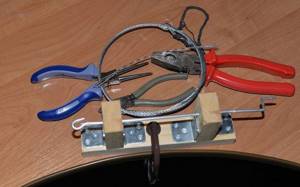
A classic leash is considered to be one that is devoid of any additional elements. To make it from materials you will need a guitar string .
For catching pike, large perch and for fishing in places where there are various obstacles on the bottom, you should purchase string No. 2 . A standard string is 85 centimeters long and at least three leashes can be made from it. Its diameter is usually 0.32-0.33 millimeters.
To catch medium and small perch, use string No. 1 , the diameter of which is approximately 0.15 millimeters. Strings are purchased in music stores, of which there are currently incomparably fewer than fishing stores, so sometimes it is easier to buy a ready-made leash than to make it yourself.
Expert opinion
Knipovich Nikolai Mikhailovich
Zoologist, hydrobiologist. I am interested in fishing at a professional level.
Important! The string must be made of stainless steel. You should read information on the Internet about which strings are worth buying and which are not. At one time, the best strings suitable for making leashes were considered to be products from the Ramenskoye factory.
Tools:
A classic type leash is made as follows:
- Bite off a piece of string of the required length.
- Bend one end to form a loop.
- Clamp the loop in a vice, leaving a protruding end about 2 centimeters long.
- Insert a nail into the loop and make 8-10 turns.
- Or they carry out the same operation, but with the help of pliers.
- Perform the same actions with the other end of the leash.
With a swivel at the end
Some anglers believe that the leader loop can cut the line, but this is not true. Those who are afraid that the string will cut the cord use a swivel. In fact, a swivel is necessary if you have to fish with spinners, which, as you know, have the ability to twist the line. In order to equip a string leash with a swivel, you simply put the latter on the loop before twisting it. If desired, the swivel can always be removed.
How to straighten
During the fishing process, the leash may become deformed for one reason or another. You can straighten it with a lighter, which anyone, even a non-smoking fisherman, should always have. To straighten the leash, perform the following steps:
- Secure one end of the leash so that it remains in place when the leash is pulled.
- Pull the leash with force, holding its other end.
- Pass the lighter flame along the entire length.
Making a fluorocarbon leash
For leashes I use Strike Pro fluorocarbon leash with a cross section of 0.6 mm.
The main difficulty I encountered when making leashes from 0.6 fluor was the knots. No fishing knot I know of fits here due to the stiffness of the material. I advise you to try tying any knot yourself, and you will understand everything yourself.
The method using crimp tubes also did not justify itself. The leash could not withstand a load of more than 4 kg and constantly tore at the crimp point. And when the tube was slightly compressed, the loop was tightened tightly, and in the end everything broke off smoothly. This option for making reins had to be abandoned.
3 Ways to Make Fluorocarbon Leaders
Through trial and error, the optimal solution was found, and it is simply simple. Figure eight knot with the tip of the leash secured with a locking knot. Everything is simple here. We thread the carabiner into the fishing line and make a loop using a figure eight knot. Next, we tighten the knot as much as we can, after moistening it with saliva (we will use the carabiner to fasten baits).
The tip of the fluor, which sticks out, is fixed to the leash with a simple locking knot. For these purposes, you can use a braided cord. Then we tighten the locking knot, pressing it into the figure eight loop. We cut off the excess fluor, leaving about 3 mm, and lightly melt it to the locking knot. Using a lighter, we form a small patch so that the locking knot does not fly off and tightly presses the figure eight loop.
We measure no more than 40 cm and cut the fishing line from the spool. We form the second loop at the opposite end of the leash in exactly the same way, only without a carabiner. It is possible without a swivel; this loop will be attached to the main cord or fishing line. You should get a leash from 25 cm to 30 cm. You should not make a longer leash, it will make it difficult to cast the bait.
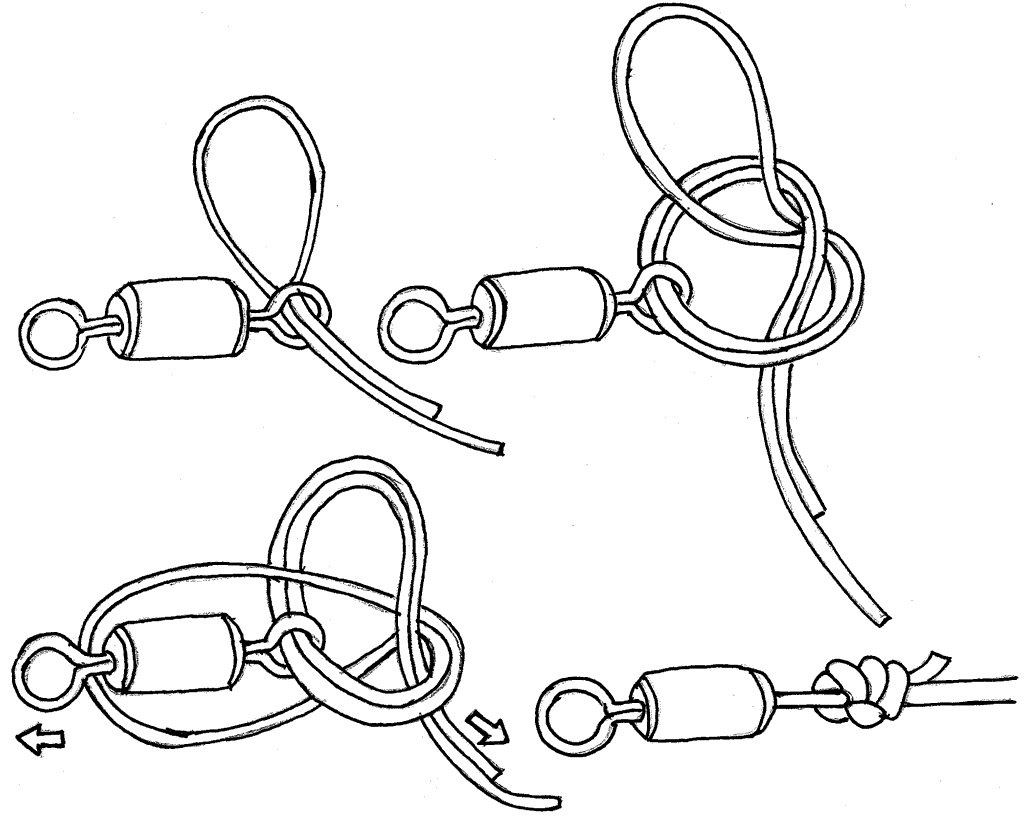
Such a knot in the manufacture of leashes from fluorocarbon fishing line with a cross-section of 0.6 mm is very simple to implement. It is reliable and can withstand tensile loads of up to 15 kg. You can attach such a leash to the main line or cord using a knotless leash. Or simply tie it to the loop of the leash or swivel (if used) with an “improved clinch” knot.
Equipment
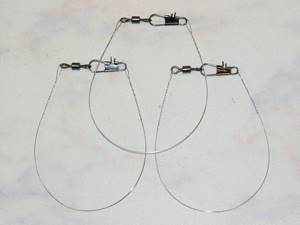
Thanks to the fact that there are twists at both ends of the leash that can be easily untwisted and twisted, it can be equipped with anything. The most common equipment is the following elements:
- swivel;
- clasp. Some anglers do not like to deal with twisting operations and prefer to equip the leader with the type of fasteners they like;
- cambrics. The cambrics are put on top of the twist. They prevent spontaneous unwinding of the twist, prevent the line from coming into contact with the twist, and give the leash a more aesthetic appearance.
